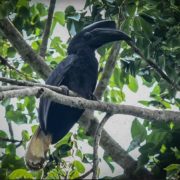
Los Banos, Laguna — The ASEAN Centre for Biodiversity (ACB) will partner with the Philippine Biodiversity Conservation Foundation (PBCF) and the local government units of Tawi-Tawi, Philippines, in a project aiming to save one of the world’s rarest birds Sulu hornbill and establish its links to other bird species in the region.
“Sulu hornbills have a genetic connection with other hornbills that can be found in other countries in Southeast Asia,” ACB Executive Director Theresa Mundita Lim said announcing ACB’s project in a recent visit to Panglima Sugala, a municipality of Tawi- Tawi.
Lisa Paguntalan, head of the PBCF, underscored Tawi-Tawi’s importance in ASEAN’s biodiversity conservation efforts. “Tawi-Tawi lies along the borders of the faunal regions of the Philippines and Wallacea— a place of wonder, a living laboratory for the study of evolution, a melting pot for faunal genetic diversity,” she said.
More than 60 per cent of the remaining forests in Tawi-Tawi are concentrated in Panglima Sugala, known as home to the iconic Sulu hornbill (Anthracoceros montani). Endemic to Sulu Archipelago, Sulu hornbill has been listed as a critically endangered bird, with only 27 of them left in the wild, according to a recent count of the BirdLife International.
“The beautiful islands of Tawi-Tawi, with most of the vegetation still intact, are known to host terrestrial birds and endemic and migratory water birds. However, the knowledge that we have about them, including their behaviour and distribution pattern, is limited,” Lim said.
The ACB and the PBCF will work with local government units in identified sites of documented threatened species, line agencies, and schools and universities within the province to monitor the threatened birds and update their status in important forest and migratory sites.
Lim said the ACB, as it taps into Tawi-Tawi’s biodiversity, hopes to gain a deeper understanding of the evolution of species in the rest of ASEAN.
She said the baseline knowledge from Tawi-Tawi will have a significant impact on the ongoing biodiversity conservation on a regional level.
Communities and local government units will likewise be assisted in implementing sustained forest and wetland protection measures.
After the project’s initial implementation, the ACB intends to replicate this eventually to other ASEAN Member States.
In an interview, Juan Carlos Gonzales, bird curator and University of the Philippines professor, said Tawi-Tawi still hosts several bird species that are endemic to the Philippines and other countries in Southeast Asia, such as the Asian koel and mangrove blue fly-catcher.
Apart from the Sulu hornbill, among the threatened species that can be found in Tawi-Tawi are Christmas island frigatebird (Fregata andrewsi), Chinese egret (Egretta eulophotes), great knot (Calidris tenuirostris,) Sulu bleeding-heart (Gallicolumba menagei), Tawi-Tawi brown-dove (Phapitreron cinereiceps), Grey imperial-pigeon (Ducula pickeringii), Philippine spinetail (Mearnsia picina), Sulu boobook (Ninox reyi), rufous-lored kingfisher (Todiramphus winchelli), Sulu pygmy woodpecker (Picoides ramsayi) Philippine cockatoo (Cacatua haematuropygia), Sulu racquet-tail (Prioniturus verticalis), celestial monarch (Hypothymis coelestis), and Sulu bulbul (Hypsipetes haynaldi).
The ACB, an intergovernmental organization, recognises the crucial role that birds play in the region’s biodiversity conservation given that these are indicators of the general state of biodiversity, or the variety of life, in an area.
—
Stay updated with news and information from the ASEAN Centre for Biodiversity by visiting their website at https://aseanbiodiversity.org.






